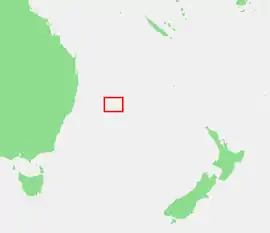| Charopella zela | |
|---|---|
| Scientific classification | |
| Domain: | Eukaryota |
| Kingdom: | Animalia |
| Phylum: | Mollusca |
| Class: | Gastropoda |
| Subclass: | Heterobranchia |
| Order: | Stylommatophora |
| Family: | Charopidae |
| Subfamily: | Charopinae |
| Genus: | Charopella |
| Species: | C. zela |
| Binomial name | |
| Charopella zela Iredale, 1944 | |
 | |
| Location of Lord Howe Island | |
Charopella zela, also known as the Mount Gower banded pinwheel snail, is a species of air-breathing land snail, a terrestrial pulmonate gastropod mollusc in the pinwheel snail family, that is endemic to Australia's Lord Howe Island in the Tasman Sea.[1]
Description
The shell of these snails are 1.6–1.9 mm in height, with a diameter of 3 mm. The colour is cream with dark orange-brown flammulations (flame-like markings). The shape is discoidal with a moderately raised spire, whorls shouldered with an angulate periphery, with coarse, moderately closely-spaced radial ribs. The umbilicus is moderately widely open. The aperture is rounded and lunate. The animal is unknown.[1]
Distribution and habitat
This very rare snail is known only from the summit of Mount Gower and the upper slopes of Mount Lidgbird, and has never been collected alive.[1]
References
- MolluscaBase eds (2021). "Charopella zela Iredale, 1944". MolluscaBase. Flanders Marine Institute. Retrieved 2021-08-24.
{{cite web}}:|author=has generic name (help)